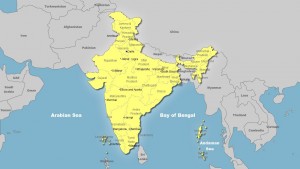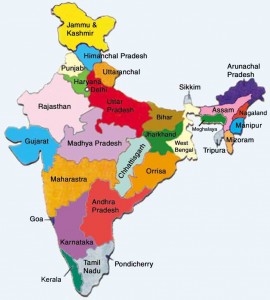India is a country with the diversity of a continent.
The cultural differences among geographical regions is so drastic that I am wary of any statement about in “Indian Culture”…Indian people traveling to different states will be faced with language barriers, unfamiliar ways of eating unrecognizable foods, different clothes and fashion, and many more “new” experiences. Traveling within India may be a very “foreign” experience to an Indian. In the same way, traveling within the United States as a U.S. citizen can evoke feelings/awareness of alienation or cultural contrasts. Therefore, as a U.S. citizen in India, I have to be cautious tip toeing around these two large categories that are often tossed around. I have no place to speak for the United States culture (whatever that means), and by interacting with small pockets of the Indian population, I have not gained an awareness of Indian culture (whatever that means). I am attempting to keep this point at the core of this blog and encourage you, reader, whether in the U.S., U.K., India or Pluto, to refrain from thinking of any country as a single story. Pakistan is not the story of terrorism and Osama Bin Ladin, India is not the story of curry and Hinduism, the U.S. is not the story of capitalism and greed. Countries are political constructs, they are not reflective of the people living in them.
HOWEVER, in order for us to understand the system of globalized politics and systems of power, these political constructs become unavoidable. So, here are some interesting statistics that may help you frame India as a political entity.
According to findthedata.com, India’s population is 1.25 billion people, 50% of which are under the legal voting age (18). The rural population in India is 825 million and the urban population is 401 million.
The U.S. has a population of 316 million. The rural population of the US is 59.2 million and the urban population is 257 million.
The population density of the U.S. is 34.56 people per sq. km, while the population density of India is 410.6 people per sq. km.
India is 2.97 million sq km while the US is 9.16 million sq km.
India is divided into 29 states, which are outlined in the map below. These states politically function within the Federal Republic of India in the same way states in the United States of America function in the Federal system.
On November
This map highlights the capitol city, Jaipur, of Rajasthan, the state in which I have spent the majority of this semester.
This is a map of Asia and the countries that directly boarder India. To view a larger image of this map, visit the link below.  http://www.funkyindia.com/pic/maps/india-map.jpg
http://www.funkyindia.com/pic/maps/india-map.jpg
All statistics used in this post are from: http://country-facts.findthedata.com/compare/1-122/United-States-vs-India

